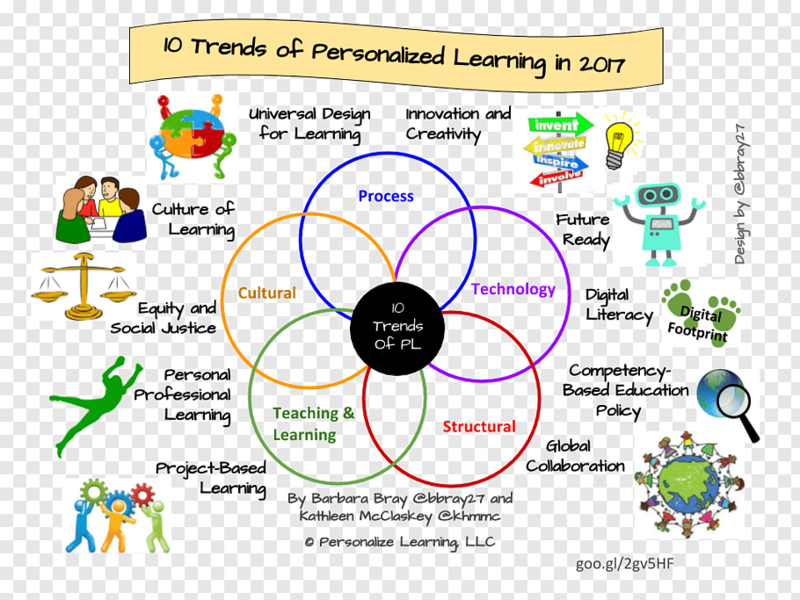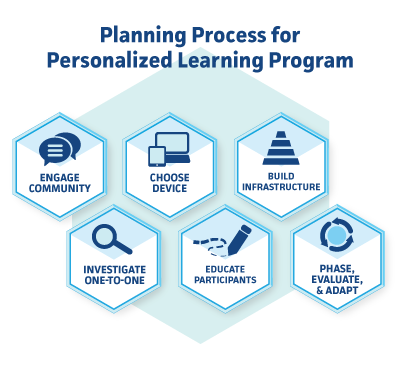e-Learning Ecologies MOOC’s Updates
Personalized learning
The advent of genome mapping led to the concept and actualization of personalized medicine to a certain extent. Each person’s genome map is different so are his learning capabilities. Hitherto, in a traditional classroom set up, everyone is taught at the same pace and given the same set of exams. Our course facilitator, Bill Copes rightly points out in “Differential Learning Part B”, that a certain similarity and uniformity is maintained in our learning systems. Generally, the teacher addresses the middle of the class and not all students are engaged in a learning process. Even evaluation system aims to achieve the bell curve and students are encouraged to work towards grades.
Today’s changing world, driven by technology, warrants to keep the students engaged and interested in studies. It is time to recognize the individual needs and break the constraints of a regular classroom and let everyone explore their learning capabilities. According to Institute for Personalized Learning “Learners are active participants in setting goals, planning learning paths, tracking progress and determining how learning will be demonstrated. At any given time, learning objectives, content, methods and pacing are likely to vary from learner to learner as they pursue proficiency relative to established standards.” Personalized learning provides leverage according to individual strengths, weaknesses, and readiness to carve their own path.
Personalized learning can be achieved through the following.
Project based learning: Project requires various dimensions to be covered starting from formulation of plan, evaluating one’s own skill sets, the approach and constant evaluation. It helps to develop critical thinking and hence, higher order thinking skills. In our institute, the students work on projects individually or in groups at different levels. It helps them not only to harness and develop scientific acumen but also make them an independent thinker, develop team-spirit and communication skills. The projects motivate the learner to accomplish a task and develop emotional, social, and intellectual skills.
Learner driven content and pace of learning: Student centric “Primary education” as well “learning needs for special students” have been explored to some extent. There is a need to expand it to the students in higher education system.
Individualized learning plans: The standards, creativity and quality of lesson plans can be the key to address the customized learning needs. The student at no point should feel overwhelmed or disengaged/ bored.
Competency-based progression: It is important to monitor the learning plan to achieve competency-based progression. Students’ full potential need to be utilised.
Blended learning: The technology can be used to the hilt to address the personalized needs of an individual learner.
Practices for personalized learning that can be followed [Nandigram et al., 2014].
Traditional setting: The small size of students group facilitates to tailor made the strategies, lessons, and activities. Our institute has tutorial classes to address such needs of students. I find them useful to understand the pulse of the class and of each learner. The tutorial sheets, assignments, discussions help me to evaluate their learning and plan my strategies accordingly.
Technology-mediated learning: Technology can enrich the experience of self-learning. The knowledge-based systems like Thermo-Tutor help to develop the learning activities according the need of a student. Internet has facilitated learning anywhere, anytime and has led to mobile learning. Game-based learning and Augmented Reality are being explored to address the challenges of traditional teaching methods.
Collaborative learning: Social media sites like Facebook, Twitter have made informal exchange of information very convenient. In our course we communicate with each other through discussion threads. Collaborative learning improves the horizon of thinking and expose us to various ideas.
Important gains from personalized learning (Fig. 1) [Kalantzis and Cope, 2015; Vargo, 2017].
Fig. 1. Different aspects of personalized learning. Accessed from https://www.pngfuel.com/free-png/fzueg
Greater ownership of self-learning: Study in Middletown, NY, demonstrated that grade 5 students developed self-reflection. Students could learn at their pace, assess, and decide if they needed help or not. YouTube video at https://www.youtube.com/watch?v=pboS77vYo68
Flexibility: It gives leverage to the students to learn at own pace using the current technologies. They can make use of the repertoire of choices available to them. Both synchronous and asynchronous learning can be easily used. The recorded learning material helps the students to learn at their own pace, make notes, and revisit the important concepts.
Utilizing digital technologies: The availability of video and other learning material at the click away, makes the learning feasible.
Interactive learning: The interaction or collaboration can overall enhance and enrich the whole learning experience. Teacher-student and peer interaction can be easily mediated simultaneously through chat, discussion threads, multimedia content. The white board can be used to illustrate the concepts and can be combined with the videos. The teaching can be easily made student centric.
Focus on knowledge production process: The choice of material available to generate knowledge is vast and it is subject to change, feedback, and collaboration. They system has become more open to constructive opinion, as a result, the student has more positive atmosphere to learn. The feeling of being judged will not be there.
Thorough involvement: Learning which is tailor-made has more chances of complete involvement.
Promotes thinking: Self-evaluation involve multiple senses and stimulate cognitive connections.
Personalized learning needs to be planned well, where students, teachers and institutes have come to a common platform (Fig. 2). Some challenges which need to be addressed.
Fig. 2. Personalized learning program. Accessed from https://www.k12blueprint.com/toolkits/personalized-learning
Readiness of schools and Institutions: Schools and Universities must be ready to change from traditional mode to personalized mode of learning.
Learner mindset: Many-a times students could prefer the classical way of teaching rather than exploring the self-learning mode.
Readiness of faculty: Faculty must be trained to break the traditional ways of teaching and adapt to technology driven learner centric approach.
Sustained engagement: The main challenge is to create and sustain the engagement of each learner. The lectures and material need to be more engaging by adding animation, video links and surprise quizzes. Flip-class concept also fits well here.
Lifelong learners: Self-learning with intrinsic motivation can commit to lifelong learning.
Personalized learning is the need of an hour. Are we ready for it? John F. Pane, a senior scientist, rightly pointed out, "Personalized learning holds promise, but there's still a lot of work to do to figure out how well this is working".
References
Herold, B. (2016) Personalized Learning: What Does the Research Say? https://www.edweek.org/ew/articles/2016/10/19/personalized-learning-what-does-the-research-say.html Accessed on Aug. 8. 2020.
Howton, R. (2019) Turn your classroom into a personalized learning environment. https://www.iste.org/explore/Personalized-learning/Turn-your-classroom-into-a-personalized-learning-environment. [Assessed Aug. 8. 2020]
Kalantzis, M., & Cope, B. (2015). Learning and new media. In D. Scott and E. Hargreaves (Eds.), The sage handbook of learning (pp. 373-387). Thousand Oaks CA: Sage.
Nandigram, D., Tirumala, S.S., Baghaei, N. (2014) Personalized Learning: Current Status and Potential. Conference: IEEE Conference on E-Learning, E-Management and E-Services 2014 At: Melbourne, Australia. DOI: 10.1109/IC3e.2014.7081251
Vargo, J., (2017) Six Examples of What Personalized Learning Looks Like. https://www.edelements.com/blog/six-examples-of-what-personalized-learning-looks-like. [Assessed Aug. 8. 2020]



